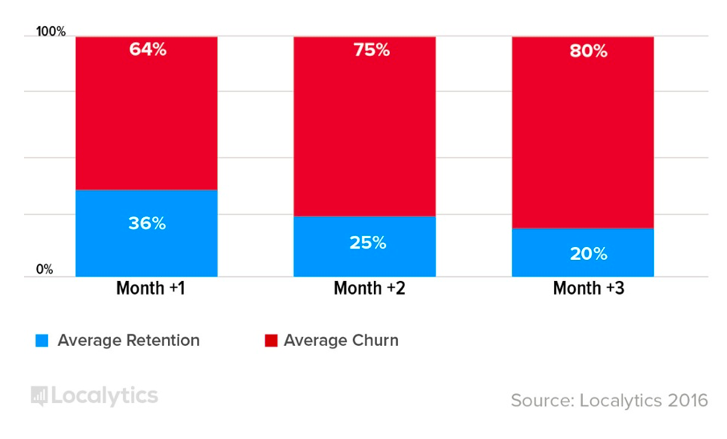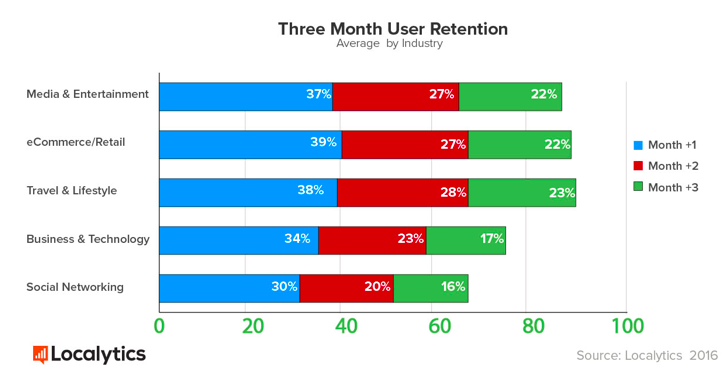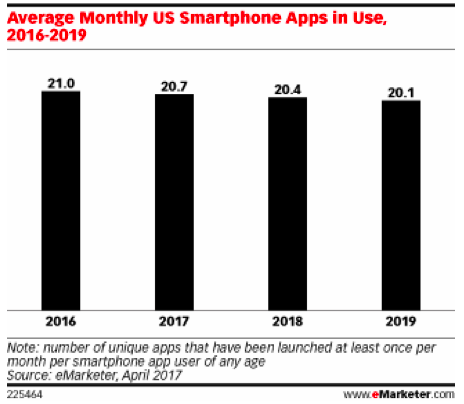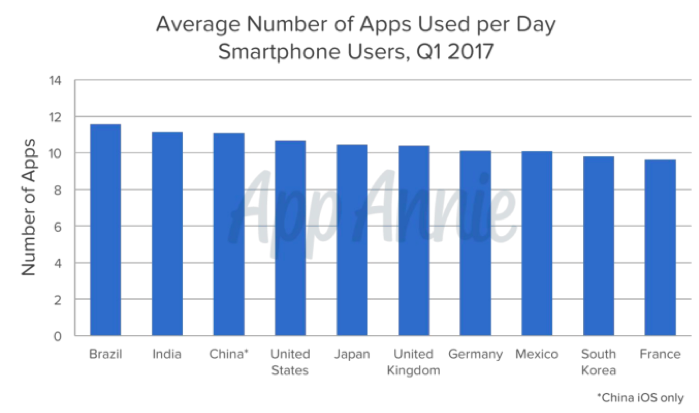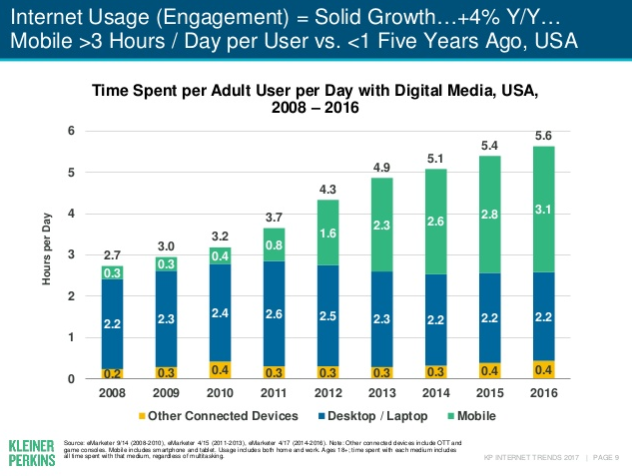Mobile apps flood the market today and are developed for various functions, such as entertainment, food delivery, taxi service, photo editing, learning, language translation, communication, shopping, videos, games, music, news, weather, and a lot more.
Apps for smartphones and other devices come out all the time, but how many are actually used by the average smartphone owner? Today’s post explores.
Mobile app usage and retention
Research Now conducted a survey in October 2015. They reported that 49% of smartphone app users in the United States use between 6 and 10 apps per week.
The next month, Pew Research Center published a report on the same topic. Their findings showed that 30% of smartphone app downloaders in the U.S. had between 1 and 10 apps on their phones, while 32% had 11 to 20 apps. A 2017 Techcrunch article stated that smartphone owners use an average of nine apps daily and access about 30 apps each month. This information was based on new research conducted by App Annie.
In 2016, a Localytics survey on three month app retention and churn showed the following statistics:
This goes to show that all app users, across all industries, 80% do not use the apps they have downloaded after three months.
To illustrate further, based on the 2016 data from Localytics, the retention rate of apps downloaded differ by industry, with media and entertainment getting retained past the three-month period.
Even though many apps are downloaded to smartphones, most aren’t kept for more than 24 hours, according to AppsFlyer. Their study found that 29.1% of Android users downloaded apps and kept them for about a day. For iOS users, the figure is slightly higher at 25.5%. When looking at retention after 30 days, just 3.2% of iOS apps and 3.3% of Android apps were still being used. Localytics conducted a similar survey in 2016, revealing that 23% of users stopped using the app they downloaded after just one use. In 2014, about 20% had abandoned their downloaded apps.
What became apparent was that retention was higher for apps that were installed for organic reasons, compared to those paid apps that were installed due to ads. Within a 30-day period, continued use of an organic app install was 156% more likely to happen on Android phones.
In 2015, the average number of apps used by smartphone owners in the U.S., tracked over four years, was 27. It went down further in 2016. According to eMarketer, smartphone users in the U.S. used about 21 apps per month on the average in 2016. By 2019, that number is expected to go down.
Compare the previous U.S. stats to the latest research findings of App Annie for the first quarter of 2017 that includes other countries.
In the same report of eMarketer, it notes that although the mobile apps market went down, users are spending more time using the apps they themselves installed and those that are organically installed on their smartphones. The number of time spent depend on the app they are using.
An average U.S. adult is likely to spend about 2.25 hours a day on mobile app in 2017. Overall, we will see an increase of usage of around 19.9% daily for the year. Based on Mary Meeker’s 2017 Internet Trends report, the number of hours smartphone owners in the U.S. use their phones connected to the Internet per day in 2016 is three hours.
Availability of apps has changed
While there are proprietary apps that offer more features and options, millions more are available for free. Based on a Statista report from March 2017, the Apple App Store had 2.2 million apps while Google Play offered 2.8 million. Amazon App Store offered 600,000 while Windows Phone Store had 669,000 available apps. This is a staggering amount and most of them are free and available for immediate download.
Businesses are riding on the bandwagon and developing many useful apps for their clients, business partners, staff and customers. Because of the international audience, most businesses also have to avail of websites and mobile apps localization to better serve their target markets.
So, how do people really use their apps?
Smartphone users download mobile apps that they think will be useful to them. Oftentimes though, many of these apps never get used. Based on a Nielsen study released in 2015, an average smartphone owner uses about 25 to 30 mobile apps.
Monthly app usage by men is higher than female users, but not by much: 27.2% for men and 26.3% for women. However, women spend about 38 hours a month on mobile apps compared to almost 37 hours for men. In terms of ethnicities, African-Americans are the heaviest apps users, followed by Hispanics and Asian-Americans.
On the average, a smartphone owner spends 85% of their time on their native install smartphone apps. They may have an additional 25 to 30 apps installed, but only five of those are heavily used. The five non-native apps vary from user to user, according to Techcrunch. Some are engaged in social media and communication while others are into entertainment apps, such as YouTube and Netflix.
Dominant among the apps are Facebook, Google, Apple, Amazon, Yahoo, eBay, and Microsoft. Email, navigation, and shopping apps are also popular. For instant messaging, WhatsApp is dominant in the U.S., while globally, enjoying tremendous usage are Line, KakaoTalk, and WeChat.
Conclusion
It’s definite that the trend of consuming digital media using mobile devices such as smartphones will continue. Technological advancements make smartphones almost at par with the features and capability of laptop and desktop computers. These innovations make users almost inseparable to their handheld mobile devices.
With the pace of life we as a society live at today, mobile apps, especially those for entertainment and social networking, help us cope. Peering closer, most users worldwide prefer the same type of apps to others, as they are available in their own language. We may all only use a handful of apps, and the more engrained into our lives they are, the stickier they become. At that rate, maybe only using a handful of apps is enough.
Read more:

